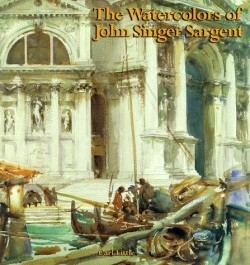The Watercolors of John Singer Sargent
Widely known and admired for his elegant portraits of high society, John Singer Sargent (1856-1925) enjoyed an extremely successful career as a painter. His artistic achievements have been well documented and important exhibitions of his work have appeared from time to time. A large show, organized by the Tate Gallery in London, is now on view at the National Gallery of Art in Washington D.C., and will travel to the Boston Museum of Art later in the year.
The focus of attention, however, has always been on the artist’s work in oil painting. Little, author of books and essays on art, writes that now “We have come a long way in recognizing Sargent’s achievements in watercolor.” He adds that art historians formerly “categorized the watercolors as “mere studies” or, worse, as “holiday” or “off duty” work, not to be taken too seriously.” Little has sought to bring evidence that the revised view of the significance of these watercolors can easily be substantiated. He has rounded up 150 glorious examples of Sargent’s watercolors, many of which are relatively unknown, to prove his thesis.
The book begins with a well-written biography, designed to provide a background of fact and anecdote pertinent to an appreciation of the part that watercolors played in Sargent’s life. Sargent was born in Florence, Italy, and spent his boyhood traveling around Europe with his American family. Little credits Sargent’s mother, a watercolorist of some skill, with developing his unerring eye for color and detail at an early age. He writes, “She was indefatigable in pointing out the particulars of the family’s surroundings, elements of architecture and landscape. This constant study would leave an indelible mark on the artist’s sensibility and remain the modus operandi that guided his work as a watercolorist.” Mrs. Sargent also instilled a love of travel in her son. Throughout his life he enthusiastically engaged in annual excursions with family and friends. Venice, the Alps and Spain were favorite destinations, but he roamed as far as the Canadian Rockies, Florida and the Mid-east. They were working vacations; Sargent painted constantly.
Little groups the selected paintings according to subject or geographical location, and provides a brief introductory text for each section. Scholars and art lovers will appreciate the good reference notes and the inclusion of many quotations by Sargent’s contemporaries. Painters will be interested to note that Sargent used quarter or half sheets of watercolor paper. This means many of the illustrations are close to the size of the original and clearly show the artist’s masterful technique: the paint strokes, the pencil under-drawing and subtle color variations.
This is good; but the real pleasure is looking at the paintings. Sargent has been described as a charming man, courteous but shy. His watercolors, however, are bold and extravagant, offering page after page of color-drenched images of astounding variety and originality. One can glide under a bridge (Sargent painted in a gondola to create the interesting perspective) on a canal in Venice, be confronted by a turbaned Bedouin in the blazing desert, marvel at a view of luminous white tents against a background of dark evergreens in a Rocky Mountain camp or come upon a tangle of alligators in the purple shadows of a palm grove. Anyone interested in watercolors will enjoy this visual treat.
Reviewed by
Joyce Moore
Disclosure: This article is not an endorsement, but a review. The publisher of this book provided free copies of the book to have their book reviewed by a professional reviewer. No fee was paid by the publisher for this review. Foreword Reviews only recommends books that we love. Foreword Magazine, Inc. is disclosing this in accordance with the Federal Trade Commission’s 16 CFR, Part 255.

